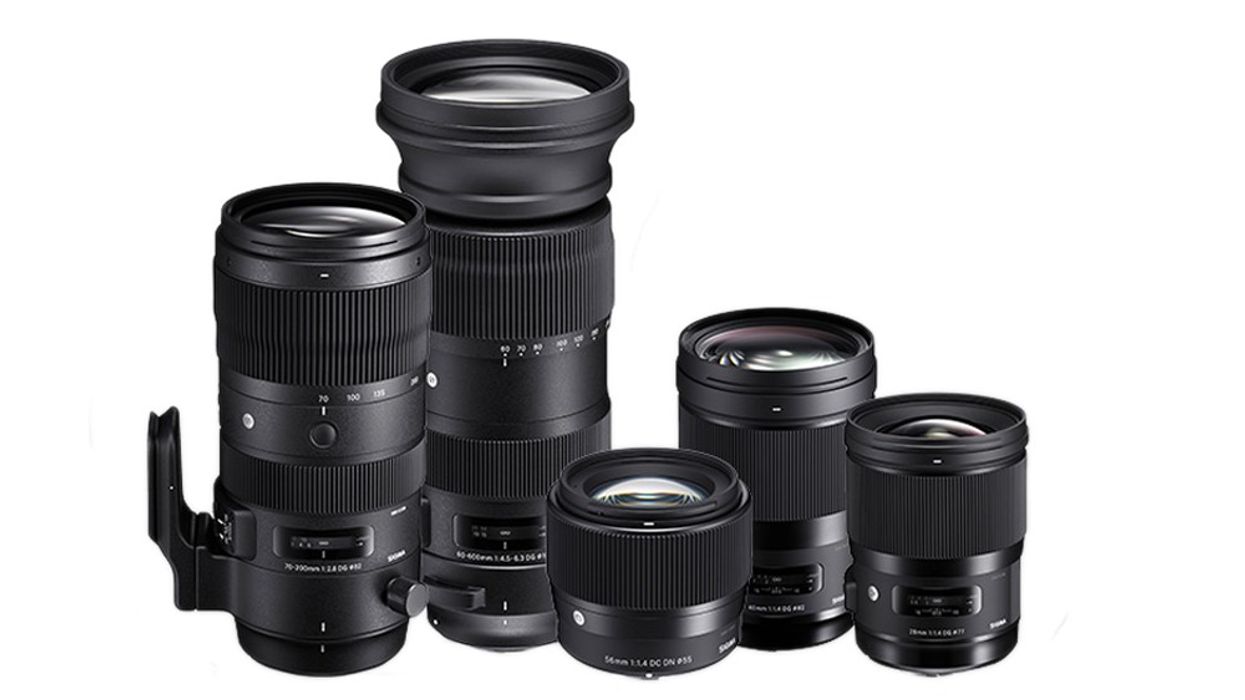Sigma Shows Off 5 New 'Global Vision' Lenses for Video and Still Shooters
Sigma adds three primes and two zooms to its Art, Sports, and Contemporary lines.

While we're still waiting to hear exactly what Sigma will be offering in its recent L-mount alliance with Panasonic and Leica, the company rolled out five new focal lengths in its Global Vision lenses that include its Art, Sports, and Contemporary lines during Photokina, a show being dominated by mirrorless tech.
The Sigma photography lenses, especially Art, have become a favorite among video shooters for its ability to produce great looking images at an inexpensive cost.
The wide angle lens covers full frame sensors and is constructed optically with 17 elements in 2 groups. Two FLD (“F” Low Dispersion) glass elements and three SLD (Special Low Dispersion) improve color separation while three aspherical lenses correct chromatic aberration. A 9 blade iris supplies a clean, soft bokeh, and its HSM (Hyper Sonic Motor) offers high-speed autofocus. The 28mm marks the five wide angle prime lens for Sigma ranging from 14mm to 35mm.
Each of the lenses feature F1.4 with the exception of the 14mm at F1.8. The lens is available for Sigma, Nikon, Canon, and Sony E-mounts.
28mm F1.4 Tech Specs:
- Lens Construction: 17 elements in 2 groups
- Angle of View: (35mm)75.4°
- Number of Diaphragm Blades:9 (Rounded diaphragm)
- Mininum Aperture:F16
- Minimum Focusing Distance:28cm / 11 in.
- Filter Size: φ77㎜
- Maximum Magnifications: 1: 5.4
- Dimensions: 82.8mm × 107.7mm (3.3 in. x 4.2in.)
40mm F1.4 DG HSM Art
Another full frame lens, like the rest of the Art series, this features a dust-and-and-splash-proof design. Optically, 16 elements in 2 groups features three FLD (“F” Low Dispersion) and three SLD (Special Low Dispersion) glass elements to thwart chromatic and magnification chromatic aberration.
According to Sigma, the 40mm F1.4 has a distortion of 1% or below and a sagittal coma flare and is capable of 8K-compatible resolution. Canon users should note its compatibility with its Lens Aberration Correction and Sigma includes the electromagnetic diaphragm mechanism for Nikon shooters. It's available for Sigma, Nikon, Canon, and Sony E-mounts.
40mm F1.4 Tech Specs:
- Lens Construction:16 elements in 12 groups
- Angle of View: (35mm)56.8°
- Number of Diaphragm Blades:9 (Rounded diaphragm)
- Mininum Aperture:F16
- Minimum Focusing Distance:40cm / 15.7 in.
- Filter Size:φ82㎜
- Maximum Magnifications: 1: 6.5
- Dimensions: 87.8mm x 131mm / ø3.5in. x 5.2in
- Weight: 1200g / 42.3 oz.
The telephoto lens features a fast F2.8 aperture with the physical size that remains the same at its different focal lengths. The 70-200mm makes it Sigma's third F2.8 zoom alongside the 14-24mm DG HSM and 24-70mm OS HSM which are both Art lenses. Optically, Sigma packed it with 24 elements in 22 groups—nine of which are FLD (“F” Low Dispersion) glass elements and a single SLD (Special Low Dispersion) glass element. There is an 11 blade aperture design, its HSM (Hyper Sonic Motor) for autofocus, a manual override switch, and a focus limiter. The lens is available for Sigma, Nikon, and Canon mounts.
70-200 mm F2.8 Tech Specs:
- Lens Construction:24 Elements in 22 Groups
- Angle of View: 34.3º-12.3º
- Number of Diaphragm Blades:9
- Mininum Aperture:F22
- Minimum Focusing Distance:120cm - 47.2in
- Filter Size (mm): 82mm
- Maximum Magnifications:1: 4.8
- Dimensions: 94.2mm x 202.9mm / ø 3.7in. x 8.0in.
- Weight: 1,805g / 63.7oz.
This is the world's first 10x optical zoom telephoto lens with a 600mm tele end. Unlike its 70-200mm counterpart, the physical size of the lens does extend. It touts 25 elements in 19 groups, Sigma's Intelligent OS that's said to deliver image stabilization effect of 4 stops, HSM (Hyper Sonic Motor) for autofocus, and FLD (“F” Low Dispersion), and SLD (Special Low Dispersion) glass to correct chromatic aberration. This is Sigma's third lens to cover 600mm tele, accompanying the 150-600mm F5-6.3 DG OS HSM Sports and 150-600mm F5-6.3 DG OS HSM Contemporary, the latter being the lighter version. The 60-600mm is available for Sigma, Nikon, and Canon mounts.
60-600mm F4.5-6.3 Tech Specs:
- Lens Construction:25 Elements in 19 Groups
- Angle of View:39.6º- 4.1º
- Number of Diaphragm Blades:9
- Mininum Aperture:F22-F32
- Minimum Focusing Distance:60-260cm / 23.6-102.4in
- Filter Size: 105mm
- Maximum Magnifications:1:3.3 (200mm)
- Dimensions: 120.4mm x 268.9mm/ ø4.7in. x 10.6in.
- Weight: 2,700g / 95.2oz.
The 56mm is Sigma's third F1.4 lens for Micro Four Thirds and Sony E-mount mirrorless cameras with APS-C sized sensors alongside a 16mm and 30mm. The lens has a rounded 9 blade aperture with a single SLD glass element in its 10 element 6 group construction. Compact and lightweight, it has a smooth AF for video shooters and dust-and-splash-proof design. Sony users should note its compatibility with Sony's Fast Hybrid AF and face recognition/eye AF functions. It's available for MFT and Sony E-mount.
56mm F1.4 Tech Specs:
Pricing and availability for all five new lenses will be announced at a later date.
















